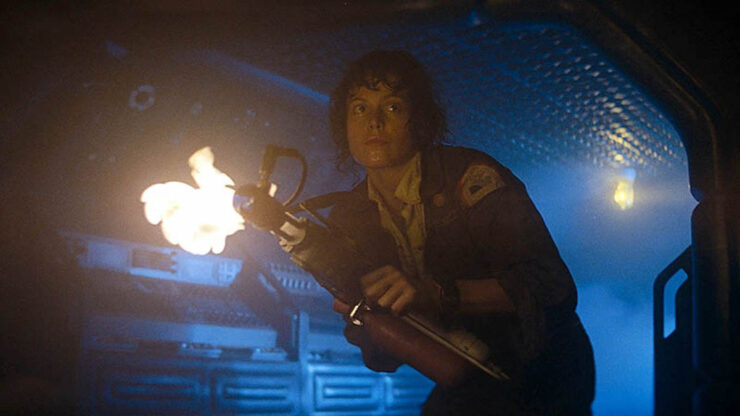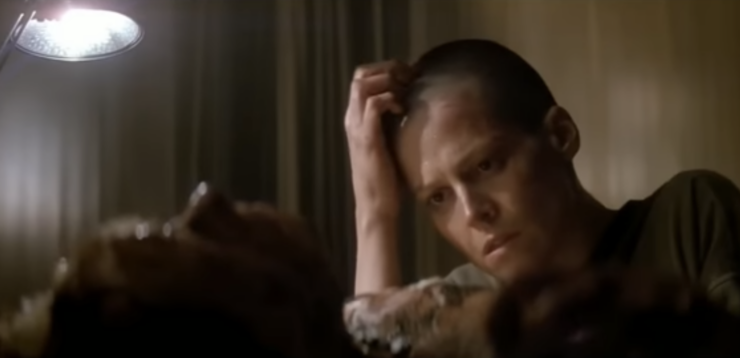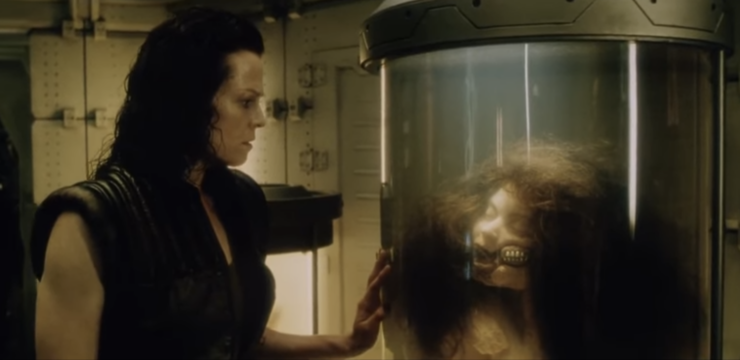In 1973, Chicago became the last major city to repeal its so-called “Ugly Law,” which barred people with visible disabilities from public spaces. Only six years later, Ridley Scott’s Alien was released, though it would be a hefty forty-two more until I watched it for the first time. I was a few months shy of eighteen when I did; a young adult trying to save up for college by working in “unskilled” labor that pushed my body beyond its limits. I spent most of my time then loathing my body for not being physically able to take as many shifts as everyone else around me, but it never made work any easier.
That was my state of mind when I first met Ellen Ripley.
Her story unlocked something in me—something I slowly came to understand over the course of watching the four original Alien movies. I wasn’t able to verbalize what it was about Ripley that meant so much to me until I watched the fourth and final film about her: Alien Resurrection. There’s a scene in which Winona Ryder’s character, Call, asks a Xenomorph-mutated clone of Ripley: “How do you go on living? How can you stand what you are?” and Ripley responds with, “Not much choice.”
I still remember the physical ache in my chest after hearing that line. Disabled people don’t choose our disabilities; we’re instead thrown into an unhelpful world and told to survive. We’re taught to hate our own existence by the kind of bigotry represented by Chicago’s law, which described us as “disgusting object[s]” and condemned us for the crime of stepping outside. By the time of 1997’s Alien Resurrection—the fourth and final movie featuring Ellen Ripley—her journey of self-acceptance mirrors the journey disabled people must take in order to learn to live with ourselves in a world like this. Her response affected me so deeply because it was the natural conclusion to her experiences and put my initial amorphous attachment to these movies into sharp focus.
Seen in the context of this journey, the first Alien movie becomes a story about the horror of initial discovery: The diagnosis that feels like it’s doomed to stalk you forever, unless you are strong enough to “beat” it. I watched this movie and immediately saw my frightened self in Ripley, desperately trying to deny my disability, impulsively fighting back like a trapped animal.

Spoiler warning: Ripley does end up beating the single Xenomorph of that first movie. It means nothing, though, because they just keep coming back. I find it amusing that this aspect of the story mimics the cycle of flare-ups that comes with many invisible disabilities, but that’s merely a side note—it’s Ripley’s full emotional arc to which I truly connected. When the Xenomorphs return in 1986’s Aliens, she attacks them with a rage that any disabled person can empathize with. If Alien is her knee-jerk reaction to the diagnosis, Aliens is the unleashing of her fury at what it’s taken from her.
In real life, that rage is often directed inwards at the disabled person’s own body, which seems understandable, but no less unfortunate for that. The body is where the pain dwells, after all. I still see my body and mind as separate, opposed entities sometimes, and I used to indulge that same frustration. It is a temptation every disabled person must learn to avoid. Of course, it’s satisfying when Ripley destroys the Xenomorphs in Aliens, but I can’t help feeling a stab of melancholy as well, thinking about how her story eventually ends.
By becoming a chimera of Xenomorph and human in Alien Resurrection, Ripley experiences unimaginable loss, but she uses that pain to travel from self-discovery to acceptance. Many disabled people follow this same path, and since the last “ugly law” in the USA was only repealed six years before the first Alien movie was released, it doesn’t stretch credibility that audiences would recognize those parallels and feel this kinship. While Ripley’s hatred towards the Xenomorphs is justified— unlike real-life examples of hatred aimed at disabled people by others (exemplified by the ugly laws), or the self-hatred inspired by such attitudes—it comes from the same place of pain. And that is where Alien 3 takes the stage in the saga of Ripley the Living Metaphor for Confronting Your Internalized Ableism.
Alien 3 begins with Ripley’s surrogate daughter and boyfriend dying during the opening credits, starkly setting the tone for the rest of the movie. It’s a story about wanting to crawl out of your skin; first implied by shots of fleas swarming over every animal we see, then snapped into focus by the revelation that Ripley is carrying a gestating Xenomorph queen in her own body. She spends the film’s entire runtime grieving and exhausted, and her spiraling despair further escalates to a climax in which she begs for death, only to ultimately take her own life. This movie follows the agony of Ellen Ripley all the way to her lowest moment. It’s a brutally honest portrayal of a woman who’s had everything taken away from her.

When I watched Alien 3 for the first time, it felt like someone finally admitting to me the truth of how deep a human can sink into despair. Misery is a difficult subject, and I feel like there’s too little speculative fiction courageous enough to really dig into its more profound depths. This agony is what happens when the kind of rage that fueled Ripley in Aliens is directed inwards, at the alien queen growing inside her. The Xenomorphs still represent the amorphous concept of “disability,” but now the metaphor is made clearer by the fact that one is now residing inside her body. It doesn’t matter that her body is an innocent bystander; she sees it as compromised, guilty of betrayal, and it becomes collateral in her quest to punish herself for her “disability.” Ripley’s arc of self-destructive depression will be familiar to anyone who has made the mistake of defining themselves by the limits of their disability instead of recognizing the strength it took for them to get as far as they have.
A key psychological factor in Ripley’s suicide is foreshadowed earlier in the movie, when she reactivates the damaged android Bishop. She promises to try and fix him, but he responds with: “I’ll never be top of the line again. I’d rather be nothing.” Some disabilities do kill, like the Xenomorph queen’s birth would kill Ripley, and I understand those who rush the process because they can’t bear to live in a body that isn’t “top of the line.” That mindset is corrosive and nearly impossible to crawl out of without help, which Ripley does eventually get (albeit after she’s already died once).
Alien Resurrection begins with the growth of a Ripley clone who, we soon learn, is essentially a byproduct of the also cloned Xenomorph queen inside her. The scientists in charge of the project decide to keep the clone, dubbed Ripley-8, in order to study her, and it’s revealed that she shares many features with the Xenomorphs: acid blood, physical resilience, quick healing, and a truly fabulous iridescent manicure. This is all handwaved away as “genetic drift,” and it’s later revealed that the cloned Xenomorph queen developed a human reproductive system as a result of this scientifically dubious exchange. The key point is the fact that Ripley is effectively half-Xenomorph now, unwillingly transformed into everything she despised.
Ripley-8 has never known an Ellen Ripley who isn’t entwined with Xenomorphs, and it clearly gives her a degree of confidence and equanimity we haven’t seen from her since the very first Alien. Hating herself or the world for being haunted by Xenomorphs (i.e., being disabled) is never a concern she developed. She doesn’t have to confront her existence until a scene about halfway through the movie, when she finds a room filled with the mutated bodies of her seven previously attempted clones. They’re grotesque, with extra faces and limbs in all the wrong places, and Ripley-8 is understandably horrified by them.
As Ripley-8 explores, she finds the seventh clone suffering but still alive, strapped down to a bare research table. In a tragic echo of the Ripley of the previous movie, Ripley-7 begs Ripley-8 to kill her. Ripley-8 obliges, sobbing the entire time, and this—this was the moment I realized that Ripley’s story is that of a disabled person. Ripley-7 clearly struggles to breathe, and nothing is being done to make her more comfortable. Like Ripley in Alien 3, she has no purpose except to hate herself and her miserable existence. Ripley-8, out of sympathy, releases her from her torment, and at the same time realizes that she could’ve easily ended up the same way. The experience of seeing her clones grants her the perspective she needs to keep herself from falling into self-hatred in the same way as her predecessors.

“How do you go on living? How can you stand what you are?” Call asks Ripley-8 not long afterwards, and this Ripley knows there isn’t any good alternative to survival. She bears resemblance to Ripley in the first Alien but reinforced by the fact that she’s already come to peace with existing in a body that isn’t fully human. She will never succumb to despair and self-hatred like all the Ripleys before her. “Not much choice,” she responds to Call, and it’s an acknowledgement of the fact that to hate what she is won’t help anyone. It’s a lesson that we learned together throughout the Alien franchise, and one that I still struggle with to this day.
We all deserve to survive, to live and thrive, regardless of the kinds of challenges we face as individuals. The Xenomorphs are outwardly violent, while the experience of living with disabilities can be inwardly violent. Either way, the body in the middle loses. It shouldn’t be a surprise, then, that coming to terms with one’s own disability can be an uncomfortable process. Disabled people live in a world where we often are treated like monsters for things we have no control over, and far too many of us internalize that view of ourselves. Ripley’s path mirrors the darkest aspects of that journey, from horror at the Xenomorphs’ existence, to disgust at partially becoming one herself, and finally acceptance: the realization that she must live with that part of herself, and the understanding that she is as deserving of life and happiness as anyone else.
I don’t know if any of the filmmakers behind these four movies meant for them to resonate with the lives and experiences of disabled individuals. What I do know is that I’ve learned how to accept my inner Xenomorph, and my life is so much better for it. I don’t have to be “top of the line” to deserve survival, and I may have to fight harder for it than other people, but it’s a worthy fight to take on. I will always be grateful to these movies for teaching me that.
Jay is a writer of speculative fiction that aims to awaken the thing that squirms wetly inside of you. Growing up queer and mixed-race in a religious family taught him that reality is uncomfortable in a box, and there’s no better way to explore that than by bending genres and turning the earthy, dirty things into something more. You can find his fiction in Anathema: Spec from the Margins, and his personal thoughts at @jellicle_jay on social media.










